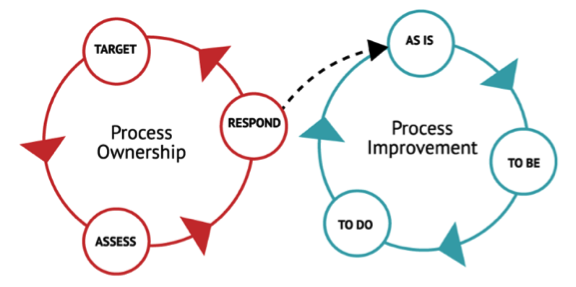Don't Close Performance Gaps; Create Them!
In our process improvement activities, we spend a lot of time fixing problems. We search out and close process performance gaps. Our methodologies are often very focused on addressing known problems. Of course, it is important that we fix problems, and there are many of them to be fixed.
However, as well as fixing problems, i.e., closing performance gaps, we should be actively looking to create new performance gaps. Yes, we need to fix problems, and we also need to find and seize new opportunities. Just because a process is meeting its KPIs doesn't mean it can't be usefully, perhaps radically, improved.
If we are doing process improvement properly then, at least occasionally, the results should be remarkable. There should be some genuine Moments of Wow!
In this column, I want to explore a few ways of digging deeper to find the opportunities beyond basic improvements, of getting beyond OK to Wow!
What's the problem?
One of the most important questions in our working (and perhaps personal) lives is "What's the problem we are trying to fix?" Not just the obvious and immediate problem, but what's the big picture context?
Think about the evolution of how we check-in for a flight. Not so long ago there was just one option and that was to join the physical queue for manual check-in. A lot of effort went into effective queue management, and many strategies were developed to optimize queue length and wait time.
I like to think that there was a meeting or workshop where participants were discussing how to make the queue more efficient and someone asked the classic What if? questions such as What if we eliminated the queue? What if people didn't need to check-in?
These days we get closer and closer to zero check-in. We've been through online and self-service check-in and now head towards the use of facial recognition and smart tech — Roger's phone just entered the building, and yes we've found his face in the crowd, so check him in and send a message with his seat details. Probably some details to sort out there but that sort of check-in will happen.
This kind of thinking challenges the idea that the problem to be fixed is efficient check-in. Sure, some form of check-in event is (probably) necessary, and we want it to be convenient for travelers and have the highest reliability and lowest cost for the airlines. The more important issue though is to free up traveler time, so they have more opportunity to spend money with the retailers who pay a lot to operate airside at the terminal.
The 'problem' to be fixed is less about how the traveler spends their time and more about how they spend their money.
You've got data
In addition to reframing the question, we might also look to see what data we have, or could have, in our processes. There would hardly be a process that doesn't have data as a byproduct. Could we do something new with that 'waste' data?
Imagine a recruitment process that received 50 responses for one advertised position. Resumes were culled; interviews were held; the ideal candidate was found; an offer was made and accepted: a successful execution of the process Recruit employee. But maybe the most valuable element of that process has been missed — we now have the full contact details, indeed the life history, of 49 people who are looking for a new job. What could we do with that?
Back to the airport check-in. The checked-in weight limit is, say, 30 kg (66 lb). I've only got 25 kgs. You've got 35 kgs. How much would you pay to use my underweight to cover your overweight and avoid having to repack your bag at the airport? Quite a lot, maybe. Could there be a secondary market in luggage allowances? The airline has all the data that would be needed. We would just need to subscribe to the service.
Would either of these two scenarios (recruitment, luggage) work? Are they viable business propositions? I don't know, but it might be worth analyzing them. In any case, they are examples of the type of thinking that pushes beyond the obvious to repurpose some process element to create new value.
What do you really do?
Another way to push our process change thinking to a new level is to take a more abstract view of what a process, or an organization, is doing and test if that abstraction gives new insights. This is best explained via an example.
Imagine that you are a designer and manufacturer of vacuum cleaners. You are very good at designing vacuum cleaners. What else could you do with all the processes involved? What is it you really do? Sure, your products clean the carpet, but what if we took a more abstract view?
We might say that we move physical material in fast moving air. Can we also move other materials? Perhaps we are not just in the cleaning business, but the material movement business.
In an even more abstract sense, we might say that what we do is create fast moving air. Is it possible then that we could use our existing expertise and processes to make washroom hand driers as well as vacuum cleaners? They are both fundamentally about fast moving air — we can blow as well as suck.
Get the circles turning
I have written elsewhere about the details of the Tregear Circles, a metamodel for process-based management, so I won't repeat that here.

Figure 1. Tregear Circles — a metamodel for management
The circles are applied one process at a time. The Process Ownership (PO) circle is about active process management. It has three nodes: target, assess, respond.
Target sets the KPIs and targets for the process in focus. Assess considers performance gaps. Respond decides what, if anything, needs to be done. Target—assess—respond is the drum beat of effective and sustained process-based management.
The assess node is critically important. First note that it is not called Measure. Two things happen at this node: we consider the reported performance against the KPI targets, and we look for any new ideas about how the process might work. We measure performance and consider ideas; we look for both problems and opportunities.
The PO circle is about both closing and creating process performance gaps.
Why? Why not? What if? What else?
Obviously, it is important that we solve current process performance problems. Having processes meet their agreed KPI targets is the main game. However, at least occasionally, we should think beyond the constraints of the KPIs to test what else might be possible.
We need to throw off the comforting familiarity of the known process and think about how we might repurpose the process and its resources to achieve something significantly better.
We need to step back from the process and reframe it in more abstract terms and then see if there are other ways in which that abstraction can be realized as a working process.
We need to ask, not just Why? but also Why not? What if? and What else?
We need to think not just about closing performance gaps, but also imagining new ones.
# # #
About our Contributor:
Online Interactive Training Series
In response to a great many requests, Business Rule Solutions now offers at-a-distance learning options. No travel, no backlogs, no hassles. Same great instructors, but with schedules, content and pricing designed to meet the special needs of busy professionals.











How to Define Business Terms in Plain English: A Primer
How to Use DecisionSpeak™ and Question Charts (Q-Charts™)
Decision Tables - A Primer: How to Use TableSpeak™
Tabulation of Lists in RuleSpeak®: A Primer - Using "The Following" Clause
Business Agility Manifesto
Business Rules Manifesto
Business Motivation Model
Decision Vocabulary
[Download]
[Download]
Semantics of Business Vocabulary and Business Rules